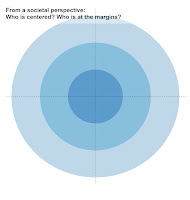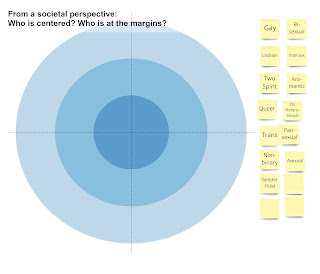[core topic]
This is part of an ongoing series
on strategically inclusive leadership.
Read the introduction here.
This idea comes partly from reading the article “Names That Matter: Exploring the Tensions of Campus LGBTQ Centers and Trans* Inclusion” by Marine & Nicolazzo. The authors studied campus LGBTQ centers to see how much focus they put on each of the letters in their name (L, G, B, T, and Q). In particular, they were interested in knowing if the focus was mostly on lesbian and gay students, and how much transgender people were included and supported. They surveyed the programs, events and services offered to find out.
You can read the article to find out what their findings were, if you want, but the real point is that there are minorities within any minority, and these minorities that can be minoritized, neglected, forgotten or oppressed even by the minority demographic that they are part of. For example, think of the wide range of disabilities that people can have, and how some of these are talked about a lot, some of them we hear about sometimes, and others are never heard about and in fact you might not even know they exist. The key point is not so much whether they are heard about or whether you know about them, but whether the lesser-known ones receive equitable treatment and support and resources. Are they included or not?
Within this strategy / concept, if you are leading a community organization, or an employee resource group, or other groups of minoritized and racialized people, consider: of the people who are part of your demographic or community, who is left out, neglected, excluded?
The second thing to do is to take action. The following quote from Yvette Flunder, a Black lesbian Bishop (from her book Where the Edge Gathers) is enlightening for this part:
"An authentic ethic of inclusion must reach from the center
to the farthest margin and work its way back."
If you wish to be inclusive, those who are at the center need to reach out to those at the farthest margins and work to bring them to the center.
strategic inclusion: within my demographic, who is at the margins? Who is the minority within the minority? How can those at the center include, serve, embrace those at the margins?
getting practical with your team
With all this in mind, regardless of the demographic that you are part of, a two-part exercise can be helpful - part 1: identification, and part 2: action steps.
preparation
Prepare two diagrams like the examples shown here.
For the first diagram, start with two concentric circles, the inner one labeled "at the center" and the outer one "at the margins" (as shown to the left), and put a list of sub-demographics that related to your group, to the side (the example below shows ones of relevance to LGBTQ2S+ groups). The overall heading is "From a societal perspective: who is centered? Who is at the margins?". You could change this as needed to be from the broader community, etc.
Then make a second diagram with two concentric circles as shown in the diagram: the inner one labeled "included" and the outer one "left out", and put a list of sub-demographics to the side. The example here shows a diagram of relevance to an LGBTQ2S+ employee resource group. The overall heading here is " Whom have we included as the __________ (name of your group or organization)? Who has been left out?" These can be done on paper, on a whiteboard or with sticky notes in person or on a whiteboard app like Miro.
part 1 - identification
Using the first diagram about the societal perspective, ask everyone to move or write the names in the parts of the circle where they should belong. They can of course also add additional items which you did not think about or which are important to them. Allow some time for discussion after people are done mapping the items.
Now, introduce the second diagram which is more specific to your group or organization, and ask everyone to move or write the names in the parts of the circle where they should belong. They can of course also add additional items which you did not think about or which are important to them.
Again, have discussion about what people learned from the second diagram, and about similarities and differences between the two diagrams…
I emphasize the importance of actually doing the exercise rather than asking people to verbally state where they feel the different subgroups land in the circles, for several reasons. First, this is useful for people who are visual learners. Secondly, seeing the result has a more concrete impact than people just saying oh this group is further to the margins, this one closer to the center. Having the diagrams up during subsequent discussions is also helpful and finally, visuals are great for sharing with others who were not present for the exercise.
part 2 - listening and planning action steps
Once those parts of your demographic which are closer to the margins are identified, you might already know some of the challenges or issues that they're facing, and might have some idea how to address them, or you might not.
In either case, it is important to reach out to those members and to listen to them, to ask them what their concerns are, what challenges they face, what gifts they would like to bring to the table but no space has been set for them, etc. What future do they envision for themselves and the broader community?
Based on what you learn from those members who are at the margins, you and the rest of the leadership team then work with them to determine what actions could address what was raised, and to prioritize the work.
real story
As a result of doing this exercise, one employee resource group (ERG) identified that several groups of gender expansive folx were at the margins. One step they took to gain more insight was to invite transgender members to come and share their concerns and needs with the steering committee. They offered a variety of options including meeting individually with the co-chairs or sending in their thoughts by email. This personal approach resulted in the majority of trans members providing feedback.
The ERG determined that two priorities for transgender and non-binary members were to have access to safe washrooms, and to have a virtual safe space to meet to support one another. Action was then taken to update and expand the inventory of gender-neutral washrooms and to review options for creating virtual spaces.
conclusion
To be strategically inclusive as a leader includes looking far and wide - to the margins - to see who is “off the radar” and being missed or sometimes even negatively perceived by those at the center, and then taking action to ensure they are prioritized, valued and embraced.
rob goetze
references
Marine, S. B., & Nicolazzo, Z (2014, November 3). Names That Matter: Exploring the
Tensions of Campus LGBTQ Centers and Trans* Inclusion. Journal of Diversity in Higher
Education. Advance online publication. http://dx.doi.org/10.1037/a0037990





No comments:
Post a Comment